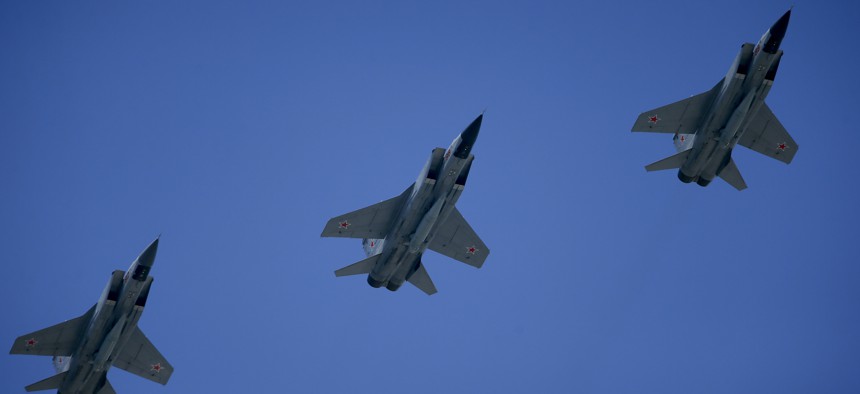
MiG-31 fighter jets with the Kinzhal missile system perform during Victory Day in Red Square in Moscow, Russia on June 24, 2020. Anadolu Agency via Getty Images / Sefa Karacan
Russia Has Fired 'Multiple' Hypersonic Missiles Into Ukraine, US General Confirms
The stunt, likely meant to intimidate Ukraine and allies, has not had the effect Moscow intended.
Russia has fired “multiple” hypersonic missiles at military targets in Ukraine, the top U.S. commander in Europe said on Tuesday, bringing some clarity to conflicting reports and claims.
On March 19, the Russian ministry of defense claimed that it had launched a Kinzhal, or Dagger, missile to strike a Ukrainian ammunition dump about 100 kilometers from the Romanian border.
The launch, most likely from a MiG-31 warplane, was the first reported combat use of one of the new classes of high-speed, highly maneuverable missiles commonly referred to as hypersonics. But the ministry’s purported video footage of the launch didn’t even show the correct date, leading to confusion about what had actually happened.
Ten days later, U.S. Air Force Gen. Tod Wolters told lawmakers that the Russian military has, in fact, launched hypersonic weapons into Ukraine.
“There have been multiple launches. Most of them have been directed at military targets,” based on a preliminary assessment of intelligence, Wolters, who leads U.S. European Command, told the Senate Armed Services Committee.
Hypersonic missiles are designed to thwart the world’s most sophisticated air defenses, so it’s unclear why Russia is using them against the Ukrainian military, which doesn’t have the sort of defenses that would merit the use of an advanced, experimental and very expensive weapon.
“I think it was to demonstrate the capability and attempt to put fear in the hearts of the enemy. And I don't think they were successful,” said Wolters.
In the meantime, the U.S. and its allies are accelerating their deliveries of air defenses and other weapons and gear to Ukraine.
“We've seen cases—for example, with a large armored brigade combat team—that we've been able to transact that in weeks as opposed to months,” Wolters said.
When Sen. Angus King, I-Maine, said the Ukrainians couldn’t wait weeks, Wolters said smaller deliveries were arriving within days.
“We have cases with smaller force elements where it would take 20 to 30 days. In many of those cases, we're down to single-digit days and less,” the general said.
The Ukrainians have said that they need upwards of 500 Javelin missiles a day to confront Russian tanks and armor.
Wolters said the Kremlin’s heavy investments in reactive tank armor and active tank protection systems don’t seem to be paying off as expected.
“This is pretty anecdotal, but the feedback we're getting is: if you have a lot of anti-tank munitions, you can slow down a tank. So even their new armor has some chinks in their armor, so to speak, with respect to multiple projectiles being launched,” he said.
Wolters said Russia has committed at least 70 percent of its total military capability to its unprovoked war on Ukraine, yet failed to topple the government or crush the outnumbered Ukrainian resistance.
On Tuesday, the Kremlin said it would scale back its operations around the capital of Kyiv during peace talks. But Russian forces have been more successful in the east of the country and along the coast between the Donbas and the annexed Crimean peninsula.
King asked Wolters whether Ukraine might “succeed in stalling the Russians or perhaps even pushing them back?”
The general replied, “Senator, I certainly believe that they can succeed in stalling the Russians.”





